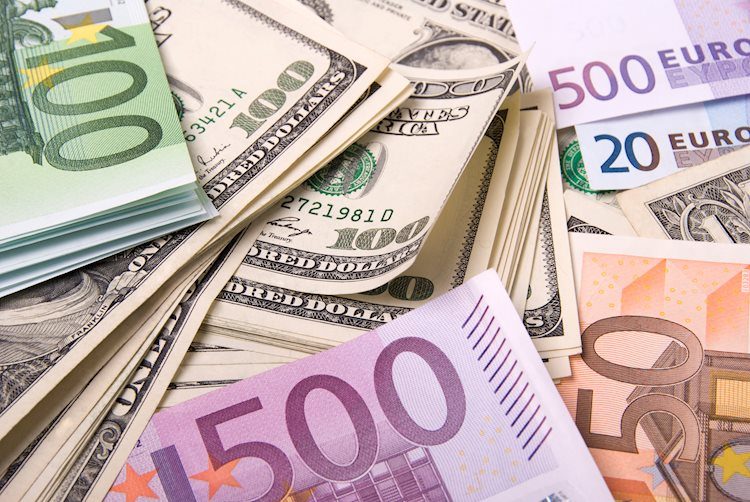- Fiber pumped the brakes on a Greenback bull run.
- Euro bidding snapped a six-day win streak despite broad-market retreat into USD.
- Rate cut expectations rule the roost as markets head into a new week.
EUR/USD churned on the low side of 1.1000 on Monday, failing to spark a meaningful pullback after dipping past the key physiological last week, but also not falling any further despite a slight miss in European Retail Sales figures. It’s all about rate cut hopes for the next few days, and upbeat US labor data has driven broad-market rate cut hopes into the floorboards.
European economic data remains tepid for most of the trading week, leaving Fiber traders to stew in their juices until Wednesday’s late-day print of the Federal Open Market Committee’s (FOMC) latest Meeting Minutes, which is sure to draw plenty of attention but unlikely to reveal anything new. The key datapoint this week from the US economic calendar will be Thursday’s latest US Consumer Price Index (CPI) inflation print.
According to the CME’s FedWatch Tool, rate traders now expect roughly an 80% chance of a single 25 bps rate trim from the Fed in November. Last week’s bumper Nonfarm Payrolls (NFP) eviscerated nearly all hopes for a double-wide rate cut in November, to the point rate traders are seeing a one-in-five chance of no rate cut at all on November 7, according to the CME’s FedWatch Tool.
EUR/USD price forecast
Fiber traders found the buy button enough to snap a six-day losing streak, but not enough to muscle intraday price action back above the 1.1000 major handle. EUR/USD has fallen into a consolidation range below the 50-day Exponential Moving Average (EMA) near 1.1040, but still north of the 200-day EMA at 1.0900. Momentum still leans in favor of the bulls, but there’s little standing in the way of broad-market risk-off flows into the Greenback.
EUR/USD daily chart
Euro FAQs
The Euro is the currency for the 19 European Union countries that belong to the Eurozone. It is the second most heavily traded currency in the world behind the US Dollar. In 2022, it accounted for 31% of all foreign exchange transactions, with an average daily turnover of over $2.2 trillion a day. EUR/USD is the most heavily traded currency pair in the world, accounting for an estimated 30% off all transactions, followed by EUR/JPY (4%), EUR/GBP (3%) and EUR/AUD (2%).
The European Central Bank (ECB) in Frankfurt, Germany, is the reserve bank for the Eurozone. The ECB sets interest rates and manages monetary policy. The ECB’s primary mandate is to maintain price stability, which means either controlling inflation or stimulating growth. Its primary tool is the raising or lowering of interest rates. Relatively high interest rates – or the expectation of higher rates – will usually benefit the Euro and vice versa. The ECB Governing Council makes monetary policy decisions at meetings held eight times a year. Decisions are made by heads of the Eurozone national banks and six permanent members, including the President of the ECB, Christine Lagarde.
Eurozone inflation data, measured by the Harmonized Index of Consumer Prices (HICP), is an important econometric for the Euro. If inflation rises more than expected, especially if above the ECB’s 2% target, it obliges the ECB to raise interest rates to bring it back under control. Relatively high interest rates compared to its counterparts will usually benefit the Euro, as it makes the region more attractive as a place for global investors to park their money.
Data releases gauge the health of the economy and can impact on the Euro. Indicators such as GDP, Manufacturing and Services PMIs, employment, and consumer sentiment surveys can all influence the direction of the single currency. A strong economy is good for the Euro. Not only does it attract more foreign investment but it may encourage the ECB to put up interest rates, which will directly strengthen the Euro. Otherwise, if economic data is weak, the Euro is likely to fall. Economic data for the four largest economies in the euro area (Germany, France, Italy and Spain) are especially significant, as they account for 75% of the Eurozone’s economy.
Another significant data release for the Euro is the Trade Balance. This indicator measures the difference between what a country earns from its exports and what it spends on imports over a given period. If a country produces highly sought after exports then its currency will gain in value purely from the extra demand created from foreign buyers seeking to purchase these goods. Therefore, a positive net Trade Balance strengthens a currency and vice versa for a negative balance.
Read the full article here

